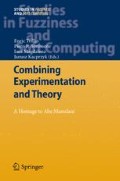Abstract
The pioneering work of Mamdani and Assilian [9] was the first practical application of a number of concepts from fuzzy-set theory [12] and fuzzy logic [15] to the solution of a family of important control problems. Inspired by ongoing developments in artificial intelligence [7], this work reported on the successful application of fuzzyset based generalizations of conventional logic, such as Zadeh’s compositional rule of inference [14], to the inferential derivation of measures of control adequacy.
Access this chapter
Tax calculation will be finalised at checkout
Purchases are for personal use only
Preview
Unable to display preview. Download preview PDF.
References
Bezdek, J.C.: Pattern analysis. In: Ruspini, E.H., Bonissone, P.P., Pedrycz, W. (eds.) The Handbook of Fuzzy Computation. ch. F6. Institute of Physics Press, England (1998)
Carnap, R.: Logical Foundations of Probability. University of Chicago Press, Chicago (1950)
Dieudonné, J.: Foundations of Modern Analysis. Academic Press, New York (1960)
Dubois, D., Esteva, F., García, P., Godó, L., Prade, H.: A logical approach to interpolation based on similarity relations. International Journal of Approximate Reasoning 17, 1–36 (1997)
Dubois, D., Lang, J., Prade, H.: Possibilistic logic. In: Gabbay, D.M., Hogger, C.J., Robinson, J.A. (eds.) Handbook of Logic in AI and Logic Programming, vol. 3. Oxford University Press (1994)
Esteva, F., García, P., Godó, L., Valverde, L., Ruspini, E.H.: On similarity logic and the generalized modus ponens. In: Proceedings of the 1994 IEEE International Conference on Fuzzy Systems, pp. 1423–1427. IEEE Press, Orlando (1994)
Feigenbaum, E.A.: The art of artificial intelligence: Themes and case studies of knowledge engineering. In: IJCAI, pp. 1014–1029 (1977)
Klement, E.P., Mesiar, R., Pap, E.: Triangular Norms. Kluwer, Dordrecht (2000)
Mamdani, E.H., Assilian, S.: An experiment in linguistic synthesis with a fuzzy logic controller. International Journal of Man-Machine Studies 7(1), 1–13 (1975)
Ruspini, E.H.: A new approach to clustering. Information and Control 15(1), 22–32 (1969)
Ruspini, E.H.: On the semantics of fuzzy logic. Int. J. of Approximate Reasoning 5, 45–88 (1991)
Zadeh, L.A.: Fuzzy sets. Information and Control 8, 338–353 (1965)
Zadeh, L.A.: Similarity relations and fuzzy orderings. Information Sciences 3, 177–200 (1971)
Zadeh, L.A.: Outline of a new approach to the analysis of complex systems and decision processes. IEEE Transactions On Systems Man And Cybernetics SMC- 3(1), 28–44 (1973)
Zadeh, L.A.: Fuzzy sets as the basis for a theory of possibility. Fuzzy Sets and Systems 1, 3–28 (1978)
Author information
Authors and Affiliations
Corresponding author
Editor information
Editors and Affiliations
Rights and permissions
Copyright information
© 2012 Springer-Verlag Berlin Heidelberg
About this chapter
Cite this chapter
Ruspini, E.H. (2012). Similarity and Implication between Fuzzy Sets. In: Trillas, E., Bonissone, P., Magdalena, L., Kacprzyk, J. (eds) Combining Experimentation and Theory. Studies in Fuzziness and Soft Computing, vol 271. Springer, Berlin, Heidelberg. https://doi.org/10.1007/978-3-642-24666-1_17
Download citation
DOI: https://doi.org/10.1007/978-3-642-24666-1_17
Published:
Publisher Name: Springer, Berlin, Heidelberg
Print ISBN: 978-3-642-24665-4
Online ISBN: 978-3-642-24666-1
eBook Packages: EngineeringEngineering (R0)

